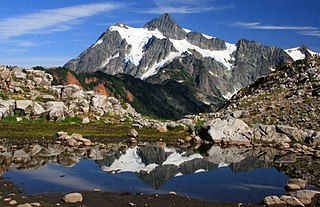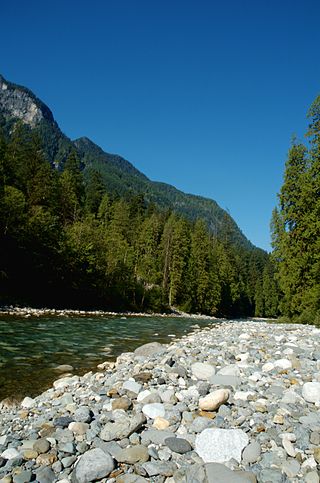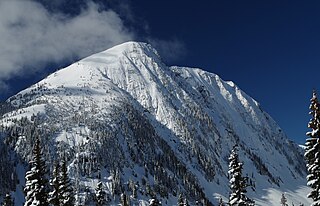
The Cascade Range or Cascades is a major mountain range of western North America, extending from southern British Columbia through Washington and Oregon to Northern California. It includes both non-volcanic mountains, such as the North Cascades, and the notable volcanoes known as the High Cascades. The small part of the range in British Columbia is referred to as the Canadian Cascades or, locally, as the Cascade Mountains. The latter term is also sometimes used by Washington residents to refer to the Washington section of the Cascades in addition to North Cascades, the more usual U.S. term, as in North Cascades National Park. The highest peak in the range is Mount Rainier in Washington at 14,411 feet (4,392 m).

The North Cascades are a section of the Cascade Range of western North America. They span the border between the Canadian province of British Columbia and the U.S. state of Washington and are officially named in the U.S. and Canada as the Cascade Mountains. The portion in Canada is known to Americans as the Canadian Cascades, a designation that also includes the mountains above the east bank of the Fraser Canyon as far north as the town of Lytton, at the confluence of the Thompson and Fraser Rivers.

The Coquihalla River is a tributary of the Fraser River in the Cascade Mountains of the Canadian province of British Columbia. It originates in the Coquihalla Lakes and empties into the Fraser River at Hope.

Coquihalla Summit is a highway summit along the Coquihalla Highway in British Columbia, Canada. It is the highest point on the highway between the cities of Hope and Merritt. It is located just south of the former toll booth plaza on the Coquihalla Highway, about 50 km (31 mi) north of Hope, and 65 km (40 mi) south of Merritt and is the divide between the Coquihalla River and the Coldwater River.

The Pemberton Volcanic Belt is an eroded Oligocene-Miocene volcanic belt at a low angle near the Mount Meager massif, British Columbia, Canada. The Garibaldi and Pemberton volcanic belts appear to merge into a single belt, although the Pemberton is older than the Garibaldi Volcanic Belt. The Pemberton Volcanic Belt is one of the geological formations comprising the Canadian Cascade Arc. It formed as a result of subduction of the former Farallon Plate.

The Hozameen Range is a mountain range in southwestern British Columbia and northern Washington, straddling the division between the Coast and Interior regions of that province. It is a subrange of the North Cascades and is neighboured on the east by the Okanagan Range and on the northwest by the unofficially-named Coquihalla Range, which lies between that river and the Fraser. In the northwest part of the range is the one named subrange, the Bedded Range.

The Skagit Range is a subrange of the Cascade Range in southwestern British Columbia, Canada and northwestern Washington, United States, which are known in Canada as the Canadian Cascades or, officially, the Cascade Mountains. The Skagit Range lies to the west of the Skagit River and east and north of the Chilliwack River and flanks the Upper Fraser Valley region of British Columbia's Lower Mainland.
Hope Mountain, commonly called Mount Hope, is a prominent mountain overlooking the town of Hope, British Columbia, Canada from the south. It is the northernmost summit of the Skagit Range of the Cascade Mountains and stands above the confluence of the Coquihalla and Fraser Rivers. Hope Mountain dominates the view of southbound travellers in the lower Fraser Canyon between Yale and Hope.

Coquihalla Mountain is an extinct stratovolcano in Similkameen Country, southwestern British Columbia, Canada, located 10 km (6.2 mi) south of Falls Lake and 22 km (14 mi) west of Tulameen between the Coquihalla and Tulameen rivers. With a topographic prominence of 816 m (2,677 ft), it towers above adjacent mountain ridges. It is the highest mountain in the Bedded Range of the northern Canadian Cascades with an elevation of 2,157 m (7,077 ft) and lies near the physiographic boundaries with the Coast Mountains on the west and the Interior Plateau on the east.

The Bedded Range is a mountain range in the Hozameen Range subdivision of the Canadian Cascades, which are the extension of the Cascade Range into British Columbia, Canada. Located between the Coquihalla and Tulameen Rivers, the Bedded Range is a dioritic plug related to the Chilliwack batholith.

The geography of the North Cascades describes a range of rugged mountains in British Columbia, Canada and Washington, United States. In Canada, the range is officially named the Cascade Mountains but is commonly referred to as the Canadian Cascades.

The Canadian Cascade Arc, also called the Canadian Cascades, is the Canadian segment of the North American Cascade Volcanic Arc. Located entirely within the Canadian province of British Columbia, it extends from the Cascade Mountains in the south to the Coast Mountains in the north. Specifically, the southern end of the Canadian Cascades begin at the Canada–United States border. However, the specific boundaries of the northern end are not precisely known and the geology in this part of the volcanic arc is poorly understood. It is widely accepted by geologists that the Canadian Cascade Arc extends through the Pacific Ranges of the Coast Mountains. However, others have expressed concern that the volcanic arc possibly extends further north into the Kitimat Ranges, another subdivision of the Coast Mountains, and even as far north as Haida Gwaii.

Jim Kelly Peak, also called Jim Kelly Mountain and Mount Jim Kelly, is the unofficial name conferred by bivouac.com for a mountain in southwestern British Columbia, Canada, located 11 km (6.8 mi) south of Falls Lake and 20 km (12 mi) west of Tulameen. It lies in the Bedded Range of the northern Canadian Cascades.

Thar Peak is a 1,940-metre (6,360-foot) mountain summit located in the Coquihalla Summit Recreation Area, in the North Cascades of southwestern British Columbia, Canada. It is situated at the east end of Zopkios Ridge, immediately west of the Falls Lake exit at Coquihalla Summit, and 1.55 km (1 mi) east of Yak Peak. Due to its close proximity to the Coquihalla Highway, the mountain attracts skiers to its slopes in winter. Precipitation runoff from the peak drains into tributaries of the Coquihalla River. The mountain was named for the thar, a Himalayan animal, and part of the ungulate names theme for several other nearby peaks that were submitted by Philip Kubik of Vancouver. The mountain's name was officially adopted on February 5, 1976, by the Geographical Names Board of Canada.

Vicuna Peak, or Vicuña Peak, is a 2,126-metre (6,975-foot) granitic horn located in the North Cascades of southwestern British Columbia, Canada. It is situated 8 km (5 mi) northwest of Coquihalla Summit, 1.47 km (1 mi) northeast of Alpaca Peak, and 1 km (1 mi) southwest of Guanaco Peak, its nearest higher peak, by a mere one metre. Precipitation runoff from the peak drains west into headwaters of the East Anderson River, or east into headwaters of the Coldwater River. The mountain was named for the vicuña, as part of the animal names theme for several other nearby peaks that were submitted by Philip Kubik of the 1974 first ascent party. The mountain's name was officially adopted on February 5, 1976, by the Geographical Names Board of Canada.

Guanaco Peak is a 2,127-metre (6,978-foot) mountain located in the North Cascades of southwestern British Columbia, Canada. It is the highest summit of the Anderson River Group, a subset of the North Cascades. It is situated 8 km (5 mi) northwest of Coquihalla Summit, and 1 km (1 mi) northeast of Vicuna Peak. Precipitation runoff from the peak drains west into headwaters of the East Anderson River, or east into headwaters of the Coldwater River. The mountain was named for the guanaco, as part of the animal names theme for several other nearby peaks that were submitted by Philip Kubik of the 1974 first ascent party. The mountain's name was officially adopted on February 5, 1976, by the Geographical Names Board of Canada.

Steinbok Peak, is a 2,012-metre (6,601-foot) granitic summit located in the North Cascades of southwestern British Columbia, Canada. It is situated 12 km (7 mi) west-northwest of Coquihalla Summit, 1.3 km (1 mi) northwest of Gamuza Peak, and 1 km (1 mi) southeast of Ibex Peak, its nearest higher peak. Precipitation runoff from the peak drains into tributaries of the Anderson River. The mountain was named for the steinbok, as part of the ungulate names theme for several other nearby peaks that were submitted by Philip Kubik of Vancouver. The mountain's name was officially adopted on February 5, 1976, by the Geographical Names Board of Canada. Steinbok was used to represent Kichatna Spire in the 1991 movie K2.

Alpaca Peak is a 2,083-metre (6,834-foot) granitic mountain located in the North Cascades of southwestern British Columbia, Canada. It is situated 8 km (5 mi) northwest of Coquihalla Summit, and 1.47 km (1 mi) southwest of Vicuna Peak, its nearest higher peak. Precipitation runoff from the peak drains west into headwaters of the East Anderson River, or east into headwaters of the Coldwater River. The mountain was named for the alpaca, as part of the ungulate names theme for several other nearby peaks that were submitted by Philip Kubik of the 1965 first ascent party. The mountain's name was officially adopted on March 23, 1976, by the Geographical Names Board of Canada.

Needle Peak is a prominent 2,095-metre (6,873-foot) mountain summit located in the Coquihalla Summit Recreation Area, in the North Cascades of southwestern British Columbia, Canada. It is situated immediately southwest of Coquihalla Summit, and 4.2 km (3 mi) south-southwest of Yak Peak. Due to its close proximity to the Coquihalla Highway, the mountain is a popular hiking destination in summer, and skiing and snowshoeing in winter. Precipitation runoff from the peak drains into tributaries of the Coquihalla River. The mountain's descriptive name was officially adopted on October 6, 1936, by the Geographical Names Board of Canada.

Zupjok Peak is a 1,835-metre (6,020-foot) mountain summit located along the northwestern boundary of the Coquihalla Summit Recreation Area, in the North Cascades of southwestern British Columbia, Canada. It is situated north of the Coquihalla Highway, west of Zopkios Ridge, 6 km (4 mi) west of Coquihalla Summit, and 4 km (2 mi) south of Alpaca Peak. Precipitation runoff from the peak drains into headwaters of the Coldwater River, as well as tributaries of the Coquihalla River and Anderson River. The mountain was named for the zupjok,, the male progeny of a cattle bull and a female yak, and part of the ungulate names theme for several other nearby peaks that were submitted by Philip Kubik of Vancouver. The mountain's name was officially adopted on February 5, 1976, by the Geographical Names Board of Canada.

















